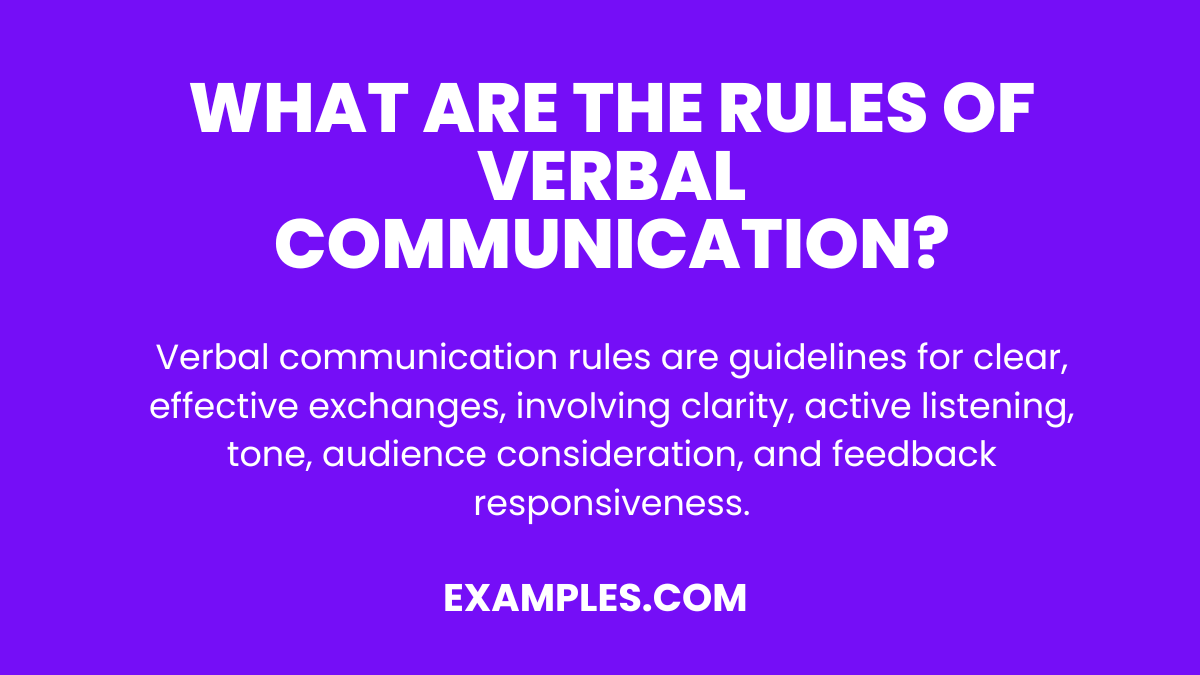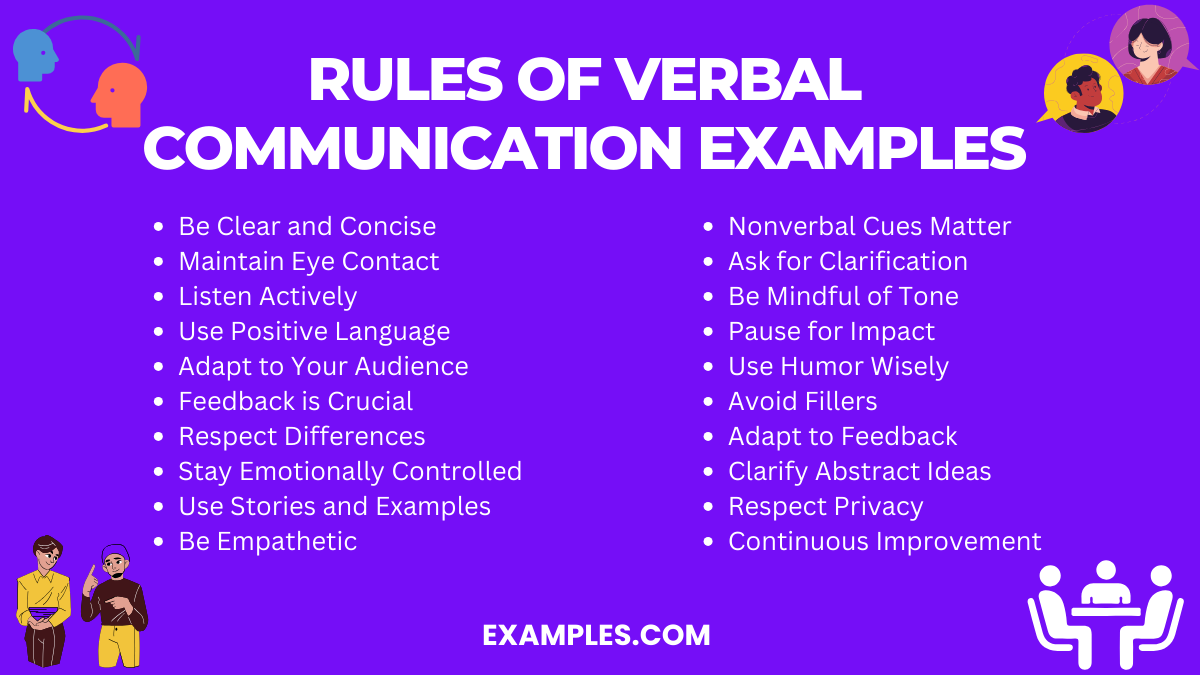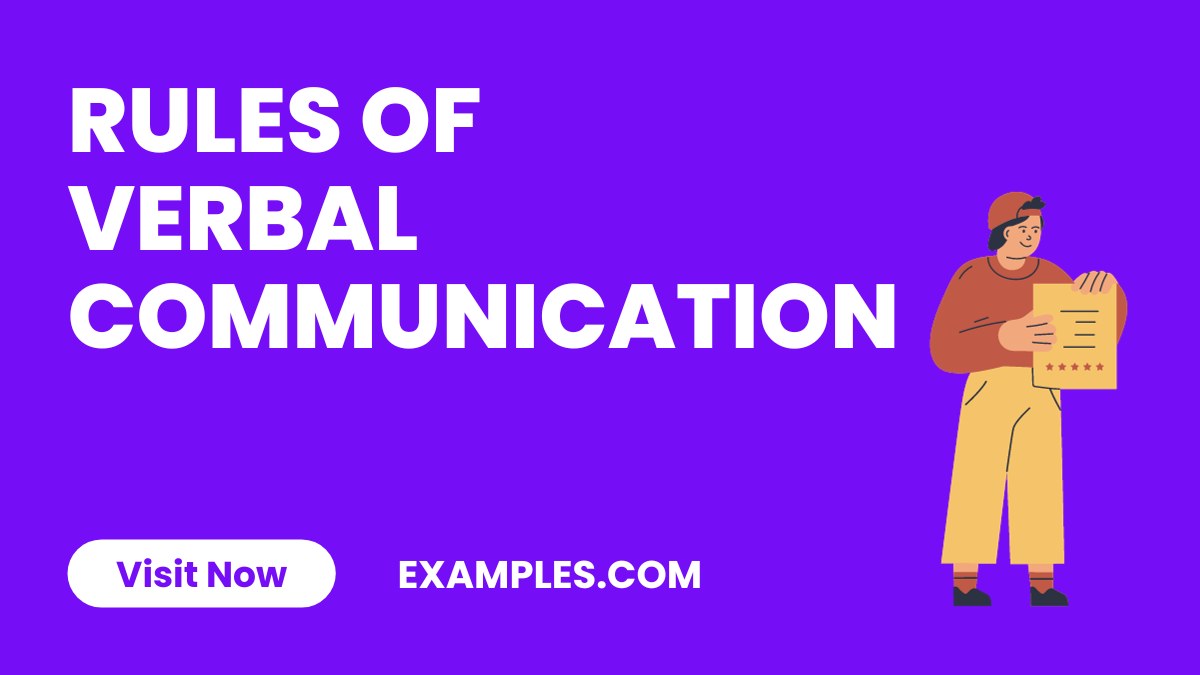19+ Rules of Verbal Communication Examples
Effective verbal communication is key to personal and professional success. This guide explores essential rules to enhance understanding, build relationships, and convey messages accurately. We’ll delve into practical strategies and Communication Examples to illustrate how you can apply these rules in various contexts. Whether you’re engaging in personal dialogue or addressing a large audience, mastering these rules will significantly improve your interaction and clarity.
Download Principles of Verbal Communication PDF
What are the Rules of Verbal Communication? – Meaning

The rules of verbal communication are guidelines that facilitate clear, effective, and efficient exchange of ideas and information. They include clarity in speech, active listening, appropriate tone and language, consideration of the audience’s needs, and feedback responsiveness. These rules ensure that the message is not only delivered but also understood and appreciated by the receiver, making interactions more productive and meaningful.
20 Rules of Verbal Communication Examples

Discover the essence of interaction with Verbal Communication Examples. Delve into a world where words create realities, representing a significant portion of our interactions. Understand how to leverage Verbal Communication Techniques to enhance your personal and professional life. Our guide elucidates the Functions of Verbal Communication and explains What Percent of Communication is Verbal? Learn the Advantages and Disadvantages of Verbal Communication and explore the various Types of Verbal Communication. Enhance your repertoire with Verbal Communication Skills and explore Ways to Improve Verbal Communication Skills through real-world examples and insightful analyses.
- Be Clear and Concise: Using jargon when simple words suffice.
- Cause: Overestimation of the audience’s understanding.
- Remedy: Choose precise, simple language tailored to your audience.
- Maintain Eye Contact: Speaking to a group while staring at the floor.
- Cause: Nervousness or lack of preparation.
- Remedy: Practice and focus on connecting with the audience.
- Listen Actively: Interrupting or formulating a response while others are speaking.
- Cause: Impatience or lack of interest.
- Remedy: Practice active listening by giving undivided attention and acknowledging others’ input.
- Use Positive Language: Saying “Don’t forget” instead of “Remember.”
- Cause: Habit or negative mindset.
- Remedy: Reframe statements positively to encourage and motivate.
- Adapt to Your Audience: Using technical terms in a non-specialist gathering.
- Cause: Misjudgment of audience’s background.
- Remedy: Know your audience and tailor your language accordingly.
- Feedback is Crucial: Not asking for or ignoring feedback.
- Cause: Overconfidence or fear of criticism.
- Remedy: Encourage and incorporate feedback to improve communication.
- Respect Differences: Not acknowledging cultural differences in communication.
- Cause: Lack of awareness or sensitivity.
- Remedy: Educate yourself on cultural norms and respect diverse perspectives.
- Stay Emotionally Controlled: Letting anger or frustration dictate your words.
- Cause: Emotional overwhelm or stress.
- Remedy: Practice emotional regulation techniques and take pauses when needed.
- Use Stories and Examples:Presenting facts without relatable context.
- Cause: Overreliance on data or technicalities.
- Remedy: Incorporate anecdotes or examples to make your message more engaging and understandable.
- Be Empathetic: Dismissing or overlooking others’ emotions.
- Cause: Self-focus or lack of understanding.
- Remedy: Practice empathy by considering others’ perspectives and emotions.
- Nonverbal Cues Matter: Inconsistent body language and spoken words.
- Cause: Unconscious habits or mixed emotions.
- Remedy: Align body language with your message for authenticity.
- Ask for Clarification: Proceeding with assumptions rather than confirming understanding.
- Cause: Hesitation to appear uninformed.
- Remedy: Always clarify doubts by asking questions respectfully.
- Be Mindful of Tone: Using an aggressive tone in sensitive discussions.
- Cause: Emotional state or unawareness of impact.
- Remedy: Modulate your tone to suit the context and maintain a respectful conversation.
- Pause for Impact: Rushing through important points without emphasis.
- Cause: Nervousness or lack of awareness.
- Remedy: Use pauses strategically to emphasize key messages and allow processing time.
- Use Humor Wisely: Inappropriate jokes in a professional setting.
- Cause: Misjudgment of the situation or audience’s preferences.
- Remedy: Understand the audience’s boundaries and use humor that is appropriate and inclusive.
- Avoid Fillers: Overuse of “um,” “like,” or “you know.”
- Cause: Nervousness or lack of preparation.
- Remedy: Practice and become more comfortable with your material to reduce reliance on fillers.
- Adapt to Feedback: Ignoring signs of confusion or boredom.
- Cause: Lack of attention to audience cues.
- Remedy: Adjust your message based on real-time feedback and engagement levels.
- Clarify Abstract Ideas: Discussing complex theories without grounding them in reality.
- Cause: Assuming shared understanding.
- Remedy: Use analogies or examples to clarify abstract concepts.
- Respect Privacy: Sharing personal information without consent.
- Cause: Overlooking confidentiality or sensitivity.
- Remedy: Always ensure information shared is appropriate and consented to.
- Continuous Improvement: Stagnating in communication skills.
- Cause: Complacency or lack of feedback.
- Remedy: Seek out new learning opportunities and feedback to continually refine your communication prowess.
Rules of Verbal Communication in Teaching
Master the art of imparting knowledge with our guide on the Rules of Verbal Communication in Teaching. Embrace techniques that foster clarity, encourage student engagement, and build a supportive learning environment. Understand the pivotal role of Verbal Communication for Teachers in shaping minds and the unique demands of Verbal Communication in the Workplace. Learn how to effectively navigate Verbal Communication in Healthcare and Verbal Communication in Business, ensuring your message resonates across various contexts and contributes to a robust educational experience.
- Incorporate Active Listening: Encourage students to paraphrase the lesson’s objectives.
- Use Analogies to Explain Complex Concepts: Relating photosynthesis to a factory production line.
- Encourage Questions and Inquisitiveness: Allowing time after each lesson for questions.
- Provide Clear and Structured Instructions: Breaking down a project into step-by-step tasks.
- Utilize Positive Reinforcement: Praising students for insightful questions or comments.
Rules of Verbal Communication in the Classroom
Mastering Rules of Verbal Communication in the Classroom is key to creating a productive learning environment. It’s vital for educators to understand and implement strategies that enhance Verbal Communication for Students, fostering a setting where learning thrives. This involves recognizing the unique challenges and opportunities within Verbal Communication for School, including those pertinent to students with special needs like Verbal Communication for Autism. Dive into the nuances of dialogue in educational settings, ensuring effective exchange of ideas and knowledge.
- Encourage Open Dialogue: Create a safe space where students feel comfortable sharing ideas and asking questions.
- Use Positive Reinforcement: Acknowledge student contributions to motivate and build confidence.
- Simplify Complex Concepts: Break down difficult subjects into understandable segments.
- Incorporate Student Experiences: Relate lessons to students’ lives for better engagement and understanding.
- Adapt to Learning Styles: Understand and utilize different verbal techniques to cater to various learners.
How can educators teach students the Rules of Verbal Communication to enhance their communication skills?
Understanding and utilizing the Rules of Verbal Communication is pivotal in honing students’ interactive capabilities. By focusing on How to Improve Verbal Communication Skills, educators can significantly boost their students’ academic and social proficiency.
- Model Effective Communication:
- Educators should demonstrate clear and effective communication, showcasing active listening, empathy, and clarity.
- Interactive Lessons:
- Incorporate role-play and group discussions to allow students to practice and understand the Importance of Verbal Communication firsthand.
- Feedback Sessions:
- Provide constructive feedback on students’ verbal interactions, highlighting strengths and areas for improvement.
- Understanding Non-Verbal Cues:
- Teach students about body language and tone, crucial aspects of Why you need Verbal Communication Skills.
- Encourage Self-Reflection:
- Prompt students to reflect on their communication encounters to identify and rectify their communication strategies.
What Role do the Rules of Verbal Communication Play in Conflict Resolution and Building Relationships?
The Rules of Verbal Communication are foundational in resolving disputes and Verbal Communication in Law Enforcement forging strong relationships. They ensure that dialogue remains respectful and constructive, underlining the Importance of Verbal Communication in interpersonal dynamics.
- Active Listening:
- Encourage parties to fully listen to each other, demonstrating understanding and patience.
- Use of I-Statements:
- Promote the use of I-statements to express feelings and thoughts without accusing or escalating the situation.
- Empathy in Communication:
- Foster an environment where empathy is expressed, allowing individuals to feel heard and understood.
- Clarity and Brevity:
- Ensure that messages are clear and concise to avoid misunderstandings and additional conflicts.
- Seeking Solutions:
- Guide individuals to use their verbal skills to negotiate and find mutually beneficial solutions, highlighting Why you need Verbal Communication Skills in conflict resolution.
Which is a Rule for Verbal Communication?
A key rule is clarity; always aim for clear, concise messages to ensure understanding. This is essential in Verbal vs Written Communication.
What are the Fundamental Rules of Verbal Communication in Conversations?
Fundamentals include active listening, clear articulation, and respectful tone, vital for both Verbal vs Oral Communication.
How can one Improve their Understanding of the Rules of Verbal Communication for better Interpersonal skills?
Engage in active listening, seek feedback, and practice empathy to enhance skills in Verbal vs Oral Communication.
In conclusion, Effective Communication is essential for building meaningful relationships and achieving success in various aspects of life. By understanding the rules, recognizing their effects on interactions, and identifying signs of communication breakdowns, individuals can work towards improving their communication skills. To fix Communication Issues, active listening, clarity, empathy, and adaptability are key. Mastering these aspects can lead to better connections and smoother interactions in both personal and professional settings.



